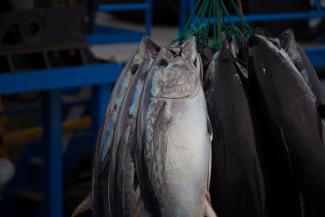
World Tuna Day 2025: Let’s celebrate the sustainability of southern bluefin
It’s World Tuna Day, and thanks to international cooperation on fisheries management, the future is looking increasingly bright for these globally favoured fish species.
In 2016, the United Nations General Assembly agreed to a Pacific Island-led initiative to put the spotlight on tuna each year to highlight the importance of these fisheries to the world’s food supply and encourage their sustainable management.
Historically, a major threat to various types of tuna has been their popularity as a food. The world’s population eats more than 5 million tonnes of the main commercial species every year. The UN tells us that since 2 May 2017, the first World Tuna Day, the proportion that comes from healthy stocks has risen from three quarters to over 90 per cent.
Recently, the effective management and sustainable harvesting practices of Australia’s southern bluefin tuna purse seine fishery were independently recognised with certification to the Marine Stewardship Council (MSC) standard.
AFMA’s CEO, Mr Wez Norris, said Australia sets a great example on the global stage for fisheries management.
“To achieve this, Commonwealth fisheries are managed collaboratively with our industry and research counterparts, to ensure fish stocks are sustainable and reduce the impacts of commercial fishing,” Mr Norris added.
“This is the world’s first MSC certification for southern bluefin. It’s a fantastic milestone that reflects decades of collaborative efforts on the part of the industry, scientists and fisheries managers, leading to significant recovery of the southern bluefin tuna stock.
“It’s a testament to the importance of international cooperation in managing tuna fisheries, in this case through the Commission for the Conservation of Southern Bluefin Tuna (CCSBT).”
The MSC certification follows an independent assessment of the fishery’s environmental impact, how it is managed and the health of the stock. This process was conducted by an independent audit firm at the request of the Australian Southern Bluefin Tuna Industry Association.
In Australia, the purse seine method is the main way southern bluefin are caught. This type of net can be set around a single school of fish near the water’s surface, largely avoiding bycatch. The fish are then towed closer inshore and transferred to permanent floating farms called pontoons. They stay in these pontoons for several months, where they grow bigger before being harvested and sold frozen.
Southern bluefin tuna are also commonly caught off the New South Wales coastline using the longline fishing method. An assessment process for MSC certification of tuna caught in this side of the fishery, driven by Tuna Australia, is currently ongoing.
Southern bluefin numbers have rebounded significantly over the past 15 years. In November 2024, it was removed from Australia’s threatened species list.
The Southern bluefin tuna fishery joins the Eastern Tuna and Billfish Fishery, which also holds MSC certification for yellowfin, bigeye and albacore tuna as well as swordfish.
Read more about the Southern Bluefin Tuna Fishery.
More information:
Media: media@afma.gov.au or 0437 869 860
www.afma.gov.au